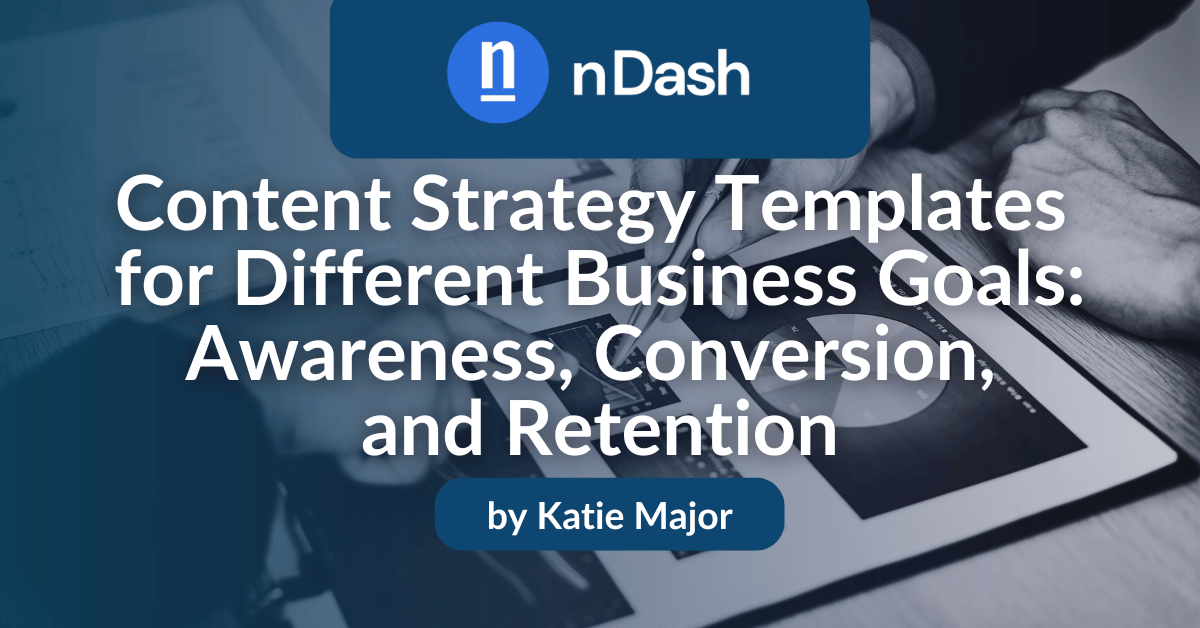It’s not uncommon for content marketers to use a single strategy template regardless of business goals. You know the one, it’s likely sitting in your Google Drive folder right now.
Templates are key for keeping you and your team organized. The most effective content strategy templates are dynamic and reflect different stages of the funnel.
Also known as: awareness, conversion, and retention.
If you’re repeatedly posting duplicate content, your readers won’t flow through all stages of the funnel. We’ve compiled this guide to help you align your content strategy template with specific outcomes and key performance indicators (KPIs).
Understanding the Content Funnel Strategy
The content funnel is an age-old (yet highly relevant) framework for marketers.
Writing for the funnel means speaking to potential customers at different phases of their buying journey. In fact, 87% of B2B marketers reported that content marketing helped them create brand awareness in the last 12 months.
Each stage of the funnel supports a different goal:
- Awareness: Build visibility and build curiosity
- Conversion: Turn curiosity and consideration into action
- Retention: Deepen trust and sustain engagement
It’s remarkably uncomplicated and makes your content strategy purposeful and effective. It makes it easier to deliver content that matches what your prospect needs to hear when it has the most impact.
Why It’s Important to Customize Your Content Strategy by Funnel Stage
Using a one-size-fits-all content strategy ultimately leads to missed opportunities and diluted messaging.
Suppose your prospect is already aware of their need and of your brand’s ability to fulfil it. Why then would you continue to publish content that doesn’t move them closer to taking action?
Think of it as doing your audience a favor by ensuring they see the content they need before deciding to buy. It builds trust, and by following the funnel, you’ll naturally create content that resonates deeper with your audience.
The proof is in the numbers: 75% of consumers are more likely to purchase from brands that deliver personalized content.
Tailoring Your Content Strategy Template for Awareness
Now that you have an understanding of the content funnel, it’s time to apply that knowledge. We’ll walk you through adapting your content strategy template to achieve top-of-funnel goals, including visibility and brand recognition.
Business Goals at This Stage
When creating or writing for the awareness phase, your focus will be on increasing reach and building brand credibility. This phase casts a wide net and is incredibly effective for all industries. It shows that 71% of B2B content marketers state that content marketing has become more critical to their organization over the last year.
Not only will you focus on building brand awareness, but you’ll also educate your audience on why they want your offer.
Here’s your opportunity to tell people why you’re different. Discuss your values, your approach, and your offerings. Why should your audience buy from you versus your competitors? Ultimately, it makes a difference, as 82% of consumers prefer to buy from brands that align with their values.
Recommended Content Formats
As mentioned above, the awareness phase encompasses a wide range of content formats to experiment with. Here are a handful of formats we recommend:
- Blog posts: Let your audience in on recent happenings and tell them who you are
- SEO-driven articles: Educate your readers while also optimizing for Google search results
- Infographics: Perfect for print marketing and enhancing your website
- Podcasts: Either hosting or guesting
- Social media content: More important than ever; 18% of marketers used social media posts as part of their content marketing strategy, 13% utilized videos
Social media is truly not a format to miss out on. Whether you favor Instagram or LinkedIn, the impact is there. In fact, 66% of social media marketers report that funny content is the most effective for their brand, followed by relatable content (63%) and trendy content (59%).
Messaging Tips
The key here is to talk to your audience as if they were a friend, student, or colleague – authentically. The tone depends on your brand voice and mission, but the key takeaway is that you’re educating, not selling.
Focus on problem-solving, gently removing objections, and thought leadership.
KPIs to Track
KPIs will help support your content efforts with hard data. Here are a few we like to keep an eye on when evaluating our own numbers:
- Impressions
- Reach
- Time on page
- Organic traffic growth
- Social shares and brand mentions.
Building a Content Strategy Template for Conversion
Optimize content in the middle of the funnel to turn interest into action. You’ve established who you are, but now we’re exploring why we should work together. Ultimately, you’re using this portion of the funnel to guide prospects toward a purchase decision.
Business Goals at This Stage
Once again, the audience knows who you are and what you offer. Our goals are to nurture leads, showcase solutions, and drive action through sign-ups, demo requests, and other key metrics.
Use this opportunity to showcase what it’s like to work with you. Highlight the results you achieve for your clients thoughtfully and effectively.
Showing your mettle works: 48% of personalization leaders are more likely to exceed their revenue goals. Additionally, 74% of B2B marketers reported that content marketing helped them generate demand and leads over the last 12 months.
Recommended Content Formats
Here are our top content formats we like to use for the middle of the funnel connection:
- Case studies: Tried and true. Gather case study data from client analytics as well as client reviews. Tell a story with your client’s experience
- Product comparison pages: Consider how Apple does this for their products
- Gated assets: Think webinars, eBooks, and whitepapers
- Social media channels: If you’ve got an Instagram account, check to see if you’re eligible to start a subscription channel or a broadcast channel
- Social media challenges: Invite followers to participate in a no or low-cost cohort to provide value and position your higher-ticket offerings at the end.
Content Strategy Messaging Tips
Position your product or service as a clear solution to their problem. Use data, testimonials, and outcome-focused language.
Another messaging point to consider is the feeling of working with you. Tap into your audience’s relief of having your product or service.
Finally, be sure to use direct and action-focused ‘calls to action’ (CTAs). Examples include:
- Book Now
- Add to Cart
- Schedule a Call
These phrases help encourage users to take the desired action.
KPIs to Track
- Lead conversions
- Digital downloads
- Demo requests
- Click-through rate
- Time spent on landing pages
- Subscription signups
Optimizing Content Strategy Templates for Retention
Let’s explore the bottom of the funnel. It’s an oft-forgotten level. Many marketers view the sale as the ultimate goal – and it is – but it’s not the only one.
Creating strategies that engage existing customers and drive loyalty brings people back, sometimes with friends.
Business Goals at This Stage
We’ve made the sale, so now it’s time to look beyond the happily ever after. That’s where you focus on improving retention, reducing churn, increasing customer lifetime value, and encouraging referrals.
Keep in mind that 52% of B2B marketers reported that content marketing helped increase loyalty among existing clients and customers.
Recommended Content Formats
Take a look at the top content formats we employ to drive loyalty and repeat business:
- Newsletters: Keep your brand top-of-mind with regular updates and tips
- Customer stories: Showcase real results and drive home the value of your product or service
- Help center content: Give customers the tools to solve common issues themselves, while also feeling supported and cared for
- Loyalty program updates: Highlight exclusive rewards, discounts, and perks for existing customers
- Webinars for existing users: Help users get more from your product and feel part of a community
Messaging Tips
Keep your tone friendly and value-focused. Your existing customers are more open to making another purchase if they are pleased with what they received.
It’s an excellent opportunity to reinforce customer success and offer exclusive insights. It’s almost like going back to the middle of the funnel, but with more built-in trust.
KPIs to Track
- Repeat purchases
- NPS
- Customer engagement rates
- Renewal rates
- Content usage among existing customers.
Using a Modular Template Approach for Strategic Alignment
Now that we’re familiar with the concepts behind the content funnel, let’s put it all into practice.
A flexible content strategy template makes it easier to adapt by funnel stage. Your team won’t need to start from scratch every time.
How to Build a Modular Template
Begin with your core components (audience, goals, KPIs, and formats) and include sections that can be toggled based on the funnel focus.
Our Favorite Tools and Platforms
In the past, Google Sheets or Google Docs was the go-to. And it still can be, but there are now plenty of platforms available that make this process much easier.
See:
- Airtable
- Notion
- Trello
- Asana
- Canva
- nDash
CMS-integrated platforms like these make collaboration across funnel stages a breeze. Many of these also incorporate various AI models to support brainstorming and content ideation.
Notable data:
- 96% of technology marketers report having a content strategy, with 29% rating it as extremely or very effective.
- 46% of marketers are using AI to create content, and 48% use it for research
- 40% of brands anticipate using GenAI tools in their business
Aligning Your Team Around Funnel-Based Strategy
Aligning stakeholders and contributors on content priorities based on a funnel strategy is crucial for making this shift successful.
It’s so important to ensure that sales, product, and customer success teams understand how content supports their objectives. It’s worth noting that only 35.5% of marketers say their training meets their career needs. Visualize the entire journey and illustrate the types of content that fill each gap.
Embed accountability and workflows into your template to keep strategy execution on track.
Make Your Content Work Harder at Every Stage
Refining your content strategy by funnel stage is all about working smarter. A one-size-fits-all approach leaves too much value on the table.
When you introduce a flexible, funnel-specific template, you can create content that meets your audience where they are, tailored to their specific needs.
Take time to audit your current strategy and identify where it’s falling flat. Minor adjustments can lead to stronger outcomes across awareness, conversion, and retention.

 Katie Major is a versatile marketing professional with a passion for content creation and strategic storytelling. She leads creative initiatives as Lead Creative at Major Marketing and serves as a Content Strategist and Copywriter at Katherine Major Creative. To learn more about Katherine — and to have her write for your brand — be sure to check out her
Katie Major is a versatile marketing professional with a passion for content creation and strategic storytelling. She leads creative initiatives as Lead Creative at Major Marketing and serves as a Content Strategist and Copywriter at Katherine Major Creative. To learn more about Katherine — and to have her write for your brand — be sure to check out her